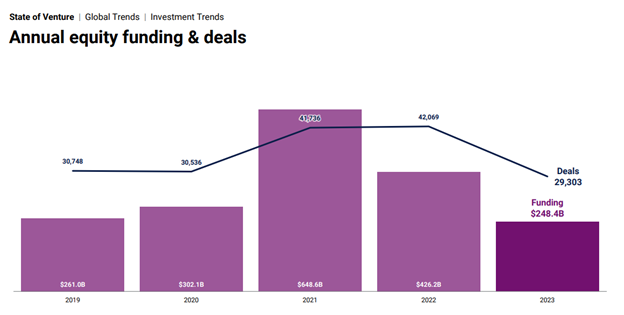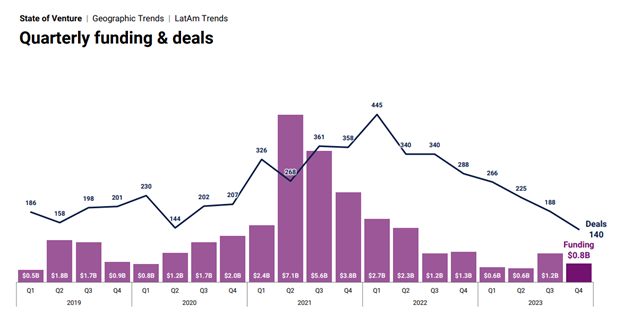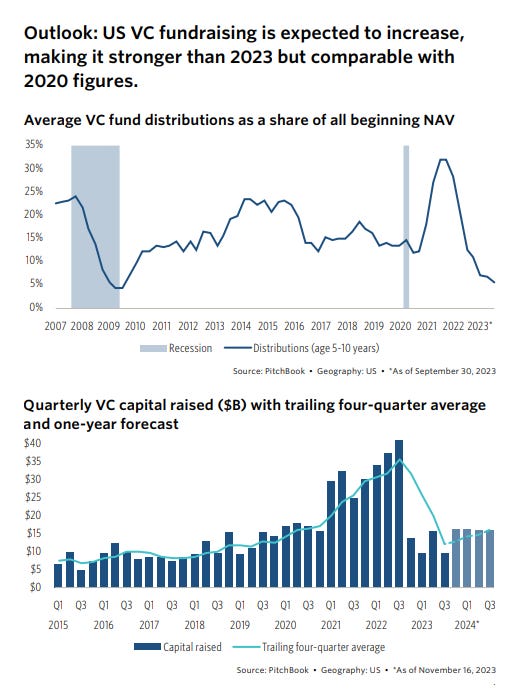

Discover more from Weekly Tech Update - Julia
LatAm Tech Weekly
#120- Powered by Nasdaq: Recap of 2023, outlooks for 2024 in VC and some key AI trends to look out!
Happy Sunday!
I'm thrilled to welcome you to the first LatAm Tech Weekly of 2024. This week's edition is a bit special – I'm diving into an insightful analysis I came across recently, which sheds light on what we can anticipate in the venture market this year.
But before we jump into that, let me give you a quick recap of my whirlwind 2023. And don't worry, we'll return to our regular format next week. Stay tuned!
Follow me on LinkedIn , Instagram or Twitter for daily updates!
Opinions expressed here are solely my own and does not represent those of people, institutions, organizations that I may or may not be associated with in any capacity, unless explicitly stated.
Reflecting on the past year, here's a snapshot of my journey and achievements:
Crafted 48 editions of the LatAm Tech Weekly newsletter
Highlighted 38 incredible 'Startups to Watch'
Wrote a whopping 65,000 characters solely on Substack. To put that in perspective, that's more content than a 200-page book!
Made waves in the media with 14 mentions across various news outlets.
Ventured into the world of audio and video, participating in 19 podcasts and videos.
Connected with the community through 28 live events as panelist.
+16,000 followers on LinkedIn and +12,000 followers on Instagram.
It's been a year of growth, learning, and connecting, and I'm excited to carry this momentum forward!
Looking back…
As I highlighted in our last edition, understanding the past is key to navigating the future of the VC industry. To that end, CB Insights recently published its State of Venture 2023 report, complete with Q4 data, and the findings are quite telling.
The report underscores a trend of ongoing market uncertainty and investor wariness, which culminated in a significant dip in venture deal activity. The last quarter of 2023 marked a 7-year low in the overall number of venture deals. The U.S., in particular, felt the brunt of this slowdown, with its quarterly deal count falling to a 10-year low, at just 2,182 deals. However, amidst this slowdown, there's a noteworthy shift: investors are increasingly focusing on early-stage investments. In fact, about two-thirds of all deals were in the early stages. This, of course, implies that securing mid- and later-stage deals has become more challenging.
This pivot in investment strategy offers a glimpse into the evolving dynamics of the venture capital landscape as we step further into the year.
Looking specifically at Latin America, funding for the region ended the year at USD 3.3bn (versus a USD 7.5bn in 2022). Early stage dominated 83% of the rounds and highlights for Q4 includes the rounds of Brazilian companies QI Tech and Jusbrasil.
Looking forward…
Pitchbook's analysis suggests that private investment managers are hoping for better days, but challenges like poor fund distributions and high interest rates could hinder recovery. The difficult exit environment has led to lower returns for both Private Equity and Venture Capital investors. As a result, Limited Partners (LPs) have less cash available for new investments. But, there is still a cautiously optimistic view for 2024 - read on!
Pitchbook's fundraising forecasts for the coming year highlight three main trends:
Given the tight conditions for exits, 2024 will be the breakout year with upwards of 100 exit transactions involving continuation funds as buyers.
With Limited Partners (LPs) hesitant about these investment vehicles, many Private Equity (PE) firms might extend their waiting period during this low-exit phase. This could lead to record-breaking holding periods for U.S. PE-backed companies, exceeding the current median of 6.4 years.
Venture Capital (VC) firms returned around $54.8 billion from 900 exits until mid-November, which was 30% less than in 2022. The upcoming year is anticipated to see a slight increase in total fundraising, comparable to the figures from 2020.
Digging a bit deeper…
The 2024 U.S. VC Outlook by Pitchbook presents a balanced view of the venture capital market, focusing on key areas like fundraising, IPOs, and late-stage dealmaking. As 2023 ends, there are positive indicators for a potential rebound in the IPO market. The U.S. economy has outperformed expectations, with a significant rise in GDP growth to 5.2% in the third quarter, easing recession fears. The Federal Reserve's halt in interest rate hikes since July 2023 has revived interest in public stocks, as seen in the S&P 500’s 19% increase in 2023. If inflation continues to cool, further rate declines could occur in 2024. This prospect is supported by the easing of supply chain disruptions from the pandemic, as reflected in the decline of the Global Supply Chain Pressure Index. These improvements, especially beneficial for companies in shipping and semiconductor production, could lead to better operational efficiency and output. For startups, enhanced production capabilities might reduce uncertainties and boost their attractiveness in the IPO market, potentially leading to a more active phase for public offerings.
The market volatility, as measured by the Cboe Volatility Index (VIX), is trending downwards, currently standing around 13, which is below the long-term median of 18. This decrease in volatility could encourage new IPO filings in 2024 by creating a stable market environment, beneficial for both issuers and investors. VC-backed startups may find this steadier market favorable for their public debut. Lower volatility also reduces the risks for investors in IPOs by minimizing concerns about abrupt market changes. Note that the stringent criteria for going public in 2024, favoring highly profitable startups, may also restrict the number of eligible VC-backed startups for IPOs. But, still - we should see a comeback of selected VC backed companies’ IPO.
In 2023, capital distribution to investors from exits reached its lowest level since 2003, amounting to just $54.8 billion from about 900 exits, a 30% decrease from 2022. This decline is mainly due to a significant drop in tech IPOs and increased SEC regulations affecting alternative exits like acquisitions. The distribution rate for VC funds aged five to 10 years has also hit a decade low. Future fundraising is expected to be around $64 billion, similar to 2020 but below 2022's peak.
The venture market continues to face challenges, such as the subdued performance of tech unicorns and increased selectivity by VC firms, leading to a high capital demand-to-supply ratio and an investor-friendly environment. However, shifts in macroeconomic factors and Federal Reserve policies could revive interest in riskier investments and open up exit opportunities, potentially enhancing fundraising prospects.
In 2024, the percentage of insider-led deals in the US venture capital (VC) sector is expected to remain high, at least for the first half of the year. This trend is driven by ongoing capital constraints, continued market volatility, and weakened investor confidence, coupled with the fact that exit channels haven't yet reopened. Since mid-2022, US General Partners (GPs) have reduced their dealmaking pace, and many institutional Limited Partners (LPs) have faced liquidity challenges, partly due to the denominator effect impacting those with public market exposure. In this environment, company valuations have decreased, and the criteria for startups to secure venture financing have become more stringent.
In recent years, U.S. venture capital (VC) fundraising saw substantial growth, with record-high capital raised, driven by significant funds like Tiger Global's $12.7 billion and Andreesen Horowitz's $20.3 billion across seven funds. The average fund size notably increased from $108.3 million in 2019 to $166.3 million in 2022, fueled by a strong economic environment and investor demand for high venture returns. However, entering 2024, the trend toward billion-dollar funds is slowing, with only 10 such funds closing through 2023 year-to-date. This slowdown is due to reduced liquidity in public markets and fewer investments from nontraditional investors, impacting the ability of mature startups to raise large rounds. In 2023 year-to-date, venture capital deployment in the U.S. significantly decreased to $135.2 billion with 239 mega-rounds, a stark contrast to the $325.6 billion and 840 mega-rounds in 2021. Consequently, the need for billion-dollar funds to participate at the top end of the VC market has lessened with the decline in large deal activities.
Wrapping up…
I need to talk about predictions in AI – or else, we would not be talking about 2023. I am brining to you some predictions by a newsletter I admire a lot called Data Driven VC. Truly recommend you to sign up!
Zooming out, 2023 was most likely the year of AI attention and 2024 will become the year of AI adoption.
#1 Reduced cost of experimentation
#2 Business models shift to “selling work”
#3 Pricing shifts to result-based
#4 Rise of AI marketplaces
#5 Vertical integration: OpenAI eats Nvidia’s lunch
#6 Rise of open source
#7 LLMs become commodity as performance converges
#8 Alliances evolve as moats become more difficult
#9 Exodus across the application layer
#10 Investors become more cautious















